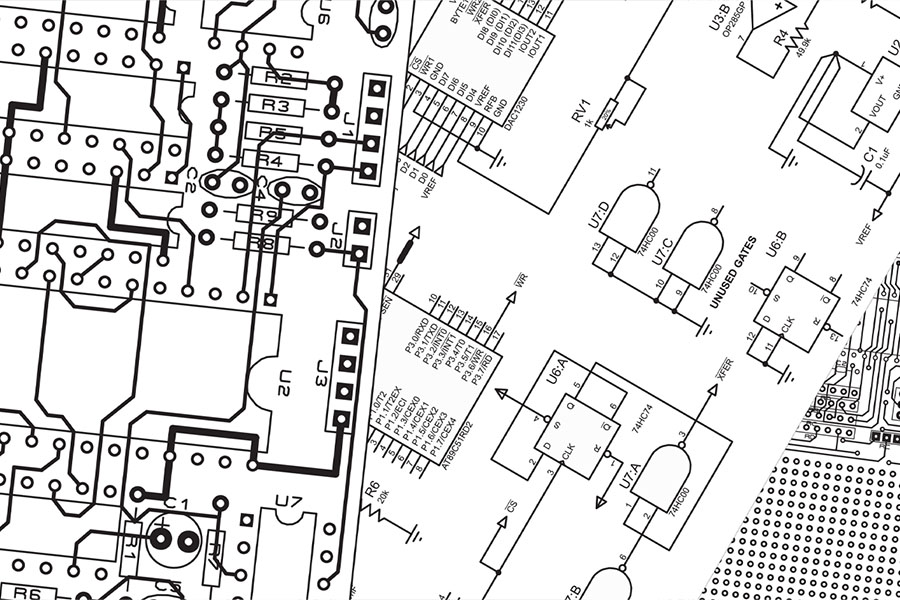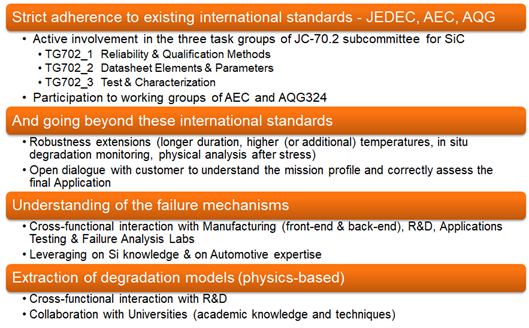Silicon Carbide (SiC)
Silicon Carbide (SiC), one of the most promising semiconductor materials used to manufacture high-power electronic devices, has exceptional physical properties. SiC-based devices offer high saturation electron drift velocity, high thermal conductivity, and high breakdown electric field. Compared to Silicon (Si) MOSFET transistors, systems based on SiC devices can attain very low losses and faster−switching speeds with smaller geometries.
Quality and Reliability Methodology
Engineers at onsemi produced a white paper, Silicon Carbide (SiC) − From Challenging Material to Robust Reliability, introducing the Quality and Reliability methodology deployed from design to mass production. This includes rigorous design methodology, strict production monitoring, manufacturing control, adequate screening, and robust qualification plans that address the unique challenges of developing SiC-based semiconductor devices. The onsemi Quality Statement/Policy fully embeds this approach.
We must understand the limiting failure modes and mechanisms to eliminate several potential process−related reliability hazards, even within the highest possible degree of reliability designed into the product. Then, we trace them back through failure analysis and feedback loops to process weaknesses and implement permanent corrective actions. The onsemi Quality − Road to Zero Defects (Figure 2) illustrates these programs that describe the general reliability specifications of onsemi.
Silicon Carbide Challenges
While Silicon Carbide material combines excellent physical properties and attractive design features, resulting in appealing solutions for manufacturing high-power electronic devices, we must consider several challenges in its design and manufacture. These contribute to superior reliability and robustness in customer mission profiles and application requirements.
Various elements must be combined to successfully and safely bring a semiconductor product to market (Figure 3).
While international standards for Silicon-based semiconductor technologies are well established, well-documented global methodologies for SiC-based are still in development. Multiple sub-teams within JEDEC, AEC, and AQG committees are at work to set a foundation for SiC standards to address this first challenge.
The second SiC technology challenge centers on a physics-based understanding of the degradation failure mechanisms to properly match material performance to the robustness and reliability requirements of customer applications, from automotive to industrial automation. These include:
- Substrate and epitaxy defectivity level
- Gate oxide: intrinsic lifetime modeling (SiC/SiO2 interface characterization) and extrinsic population (screening)
- Body diode degradation
- Reliability during high−voltage blocking (HTRB)
- Application−related performance (avalanche robustness, edge termination, short circuit, ruggedness against cosmic rays, design for high dv/dt ruggedness, surge currents)
For each degradation mechanism, the onsemi approach is rigorous and cross−functional, with the following steps: Control, Improve, Test & Screen, Characterize, and Qualify & Extract Models.
onsemi considers close collaboration with universities and research centers vital to explore the theoretical aspects of semiconductor materials and to add dedicated techniques and complementary skills that may not always be available in the semiconductor industry.
The white paper introduces recent in-depth studies performed at onsemi that focus on the following issues that present critical challenges for semiconductors:
- Bias Temperature Instability (BTI)
- Body Diode Degradation
- Dynamic Stressing
The related publications provide extensive detail into these technical topics and how onsemi SiC technology successfully addresses these challenges with robust and reliable SiC devices.
Conclusion
A rigorous design methodology, strict production monitoring, manufacturing control, adequate screening, and robust qualification plans form the foundation for onsemi to develop robust and reliable high-power silicon carbide products up to 1200 volts.
In this , learn more about how onsemi has developed a comprehensive and cross−functional methodology to assess and safely release SiC products to the market. Check the onsemi EliteSiC product family of products.









